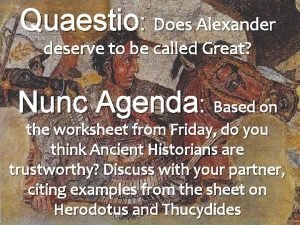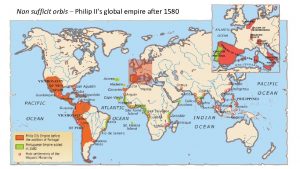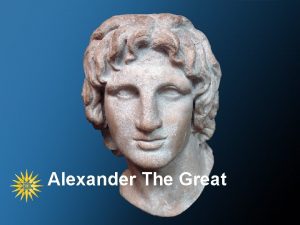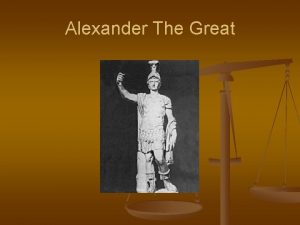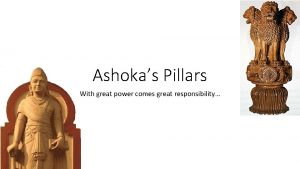Alexander the Great Early Reign Alexander comes to




















- Slides: 20

Alexander the Great Early Reign

Alexander comes to power �At approximately the age of 20, Alexander took control of the Macedonian throne. His first task was to secure this position. He had many opponents within Macedonia and from the surrounding Greek states. �Some of the native barbarian tribes, (surrounding Macedonia) wanted to break away from Macedonian control. According to Plutarch, Alexander was advised by his advisers to leave the Greek states to their own devices and to avoid confrontation. (Plutarch p. 263)

Alexander comes to power �Plutarch says that Alexander did exactly the opposite, he decided “the only way to make his kingdom safe was to act with audacity and a lofty spirit”, �In a serious of brilliant battles Alexander “swiftly crushed the uprisings” by advancing his armies up as far as the Danube.


Campaign against the Northern Tribes: Thrace �This territory bordered Macedonia. Alexander set out from Philippi, crossed the Nestus River and made his way to Mount Haemus, where an army of Thracians had been waiting for him. �The Thracians occupied the higher ground, of the narrow mountain pass and had a clear advantage. They were not going to allow Alexander through. Also, they had a number of carts to hurl down at the advancing Macedonian infantry.

Campaign against the Northern Tribes: Thrace Alexander came up with an ingenious way to counter act this. He ordered the section of his infantry who were able to break formation, to step aside when the carts were coming down the mountain. He told those soldiers who had no room to step aside on the pass, to come closer together, lie down on their bellies and cover themselves with their shields, therefore allowing the oncoming carts to bounce over their heads and not do them any harm.

Campaign against the Northern Tribes: Thrace When this plan did indeed prove to be successful, Arrian says that the Macedonian army plucked up courage, “raised a cheer and charged” P. 44 – He then brought up his archers and placed them in front of his infantry. Alexander concluded this particular battle, by capturing the women and any loot left behind by the Thracians, many of the men had ran away too quickly for them to be captured.

Campaign against the Northern Tribes: Tribali Having dealt with the Thracians, Alexander made his way to the River Lyginus. His aim was to deal with the Triballians and their leader, King Syrmus sent his women and children to the River Danube for safekeeping. Here, along the river, the two armies engaged each other. They had the advantage of shelter from nearby woods. Alexander ordered his archers and slingers to hurl missiles and drive them out of this shelter, into the open ground. Having drawn the Triballians into the open, Alexander then ordered his cavalry to attack from the right and left wing. The main body of the infantry attacked at the centre.

When the fighting was at long range, the Triballians held out for some time, but when the Macedonian cavalry came closer, they cut down the opposing army, leaving them with no chance. The Triballians fled to the nearby woods along the river. Arrian says that in spite of the heavy losses endured by the Triballians (3, 000 dead) Alexander was not “able to finish the job”. Night time had set in, hampering any chances of complete victory. Alexander made his way to the Danube where several war ships met him. His intention was to sail to the island where the Triballians and Thracians had fled. However they were met with heavy resistance.

Campaigns Against the Northern Tribes: The Getae Alexander switched his attention to the Getae, who lived on the further side of the River. The Getae had some 10, 000, infantry ready to oppose a landing. Arrian describes how, unable to land ashore, through resistance and strong currents, Alexander decided to cross the river and attack the Getae who were on the other side. Alexander used makeshift boats: tents filled with hay and dug-outs. He used these to ferry a large proportion of his army across the Danube. He also crossed at night and his troops landed on an area that had high grain stalks. This concealed his arrival.

Campaigns Against the Northern Tribes: The Getae soon lost confidence. Alexander had crossed the river with this a huge army in a single night without having to build a bridge to assist their crossing of the formidable river. The awesome sight of his well formed infantry also unnerved the Getae. The Getae soon abandoned their town and defences. Later on both these tribes and King Syrmus formed an alliance with Alexander and made peace with him.

Reading Read Arrian’s account of Alexander’s campaigns against the Northern tribes; p. 42 – 54 Using Arrian to help, summarise any two of these campaigns.

Campaign Against Thebes Some political exiles returned to Cadmia, the capital of Thebes and murdered Amyntas and Timalous, members of the existing government. Arrian describes how they then called an assembly of the people and encouraged the citizens to stand up to Alexander: in the name of “liberty” and “autonomy”. These exiles incited the city to revolt and overthrow Macedonian rule. When Alexander heard of the take over of the Theban capital he made his way down through Thessaly, entered Boeotia, and assembled his forces at Onchestus. He then marched onto Thebes.

Campaign Against Thebes Thebans were not aware of the Macedonian advance and Alexander even gave them some time to change their mind, before he advanced – but they had no intention of changing their position. On the contrary, the Thebans sent out their light infantry to attack the Macedonian forces. Alexander moved his forces to the outskirts of the city in Cademia, he was even at this stage hesitant to sack the city still hoping that the Thebans would rethink their position. According to Arrian, some of the people in the city wanted to approach Alexander for a pardon, but the political exiles that had returned to the city would not hear of it. Thebans had ringed the city with a palisade.

Campaign Against Thebes Perdiccas launched a raid on the palisades and attacked the Theban forces stationed there. Perdiccas got between the two palisades. Alexander ordered in a battalion of archers to assist him. He did not want to leave his general unsupported and exposed to the enemy. Perdiccas wounded and carried from the field. Thebans were temporarily driven back down a “sunken road”. However, they recovered and had the Macedonians in retreat. Alexander sent in his infantry and pressing hard on the Thebans, they drove them back to the city gates. The “rout became a panic”.

Campaign Against Thebes Thebans ran inside their walled city but failed to close the gates as they retreated. Once inside, Alexander’s forces swarmed the city, the fighting became intense for a short while around an area known as the Ampheum. Those who had stopped putting up any type of resistance were nevertheless slaughtered. Even women and children, who had clung to temples and Altars, were not spared.

Campaign Against Thebes Alexander finished off his destruction of Thebes by burning the city to the ground, surviving women and children were sold into slavery. Anybody with connections to Macedonia was spared: loyal priests and priestesses etc. The house of Pindar, a famous poet, was preserved.

The Aftermath Other Greek sates began to show loyalty to Macedonia, in the wake of the destruction of Thebes: The Arcadians for example, put to death any body who had suggested opposing Alexander. The Aetolians sent representatives to beg forgiveness from Alexander. The Athenians sent a delegation to Alexander stating their delight to see him back safely from Illyria. They also condemned the revolt of the Thebans.

Reading For a full account of how Alexander put down the revolt from Thebes, we must read Arrian: Book 1 P. 54 -64.

Questions 1. Give a summary of Alexander’s attack on Thebes. 2. What were the consequences of this attack for Thebes and Greece?
 Reign alexander the great
Reign alexander the great Great power comes with great responsibility
Great power comes with great responsibility With great expectations comes great responsibility
With great expectations comes great responsibility With great power comes great responsibility batman
With great power comes great responsibility batman Does alexander deserve to be called the great
Does alexander deserve to be called the great Does alexander the great deserve his title
Does alexander the great deserve his title First comes love then comes marriage
First comes love then comes marriage Early cpr and early defibrillation can: *
Early cpr and early defibrillation can: * Alexander the great relationships
Alexander the great relationships Greek and roman geography
Greek and roman geography Non sufficit orbis felipe ii
Non sufficit orbis felipe ii In 331 bce, alexander the great successfully invaded egypt.
In 331 bce, alexander the great successfully invaded egypt. Phillip of macedon
Phillip of macedon Plato teacher of
Plato teacher of Lesson 9
Lesson 9 Alexander the great mutiny
Alexander the great mutiny How did alexander plan to build his empire
How did alexander plan to build his empire Alexander empire split
Alexander empire split Alexander the great hephaestion
Alexander the great hephaestion Alexander the great summary
Alexander the great summary Alexander the great
Alexander the great




